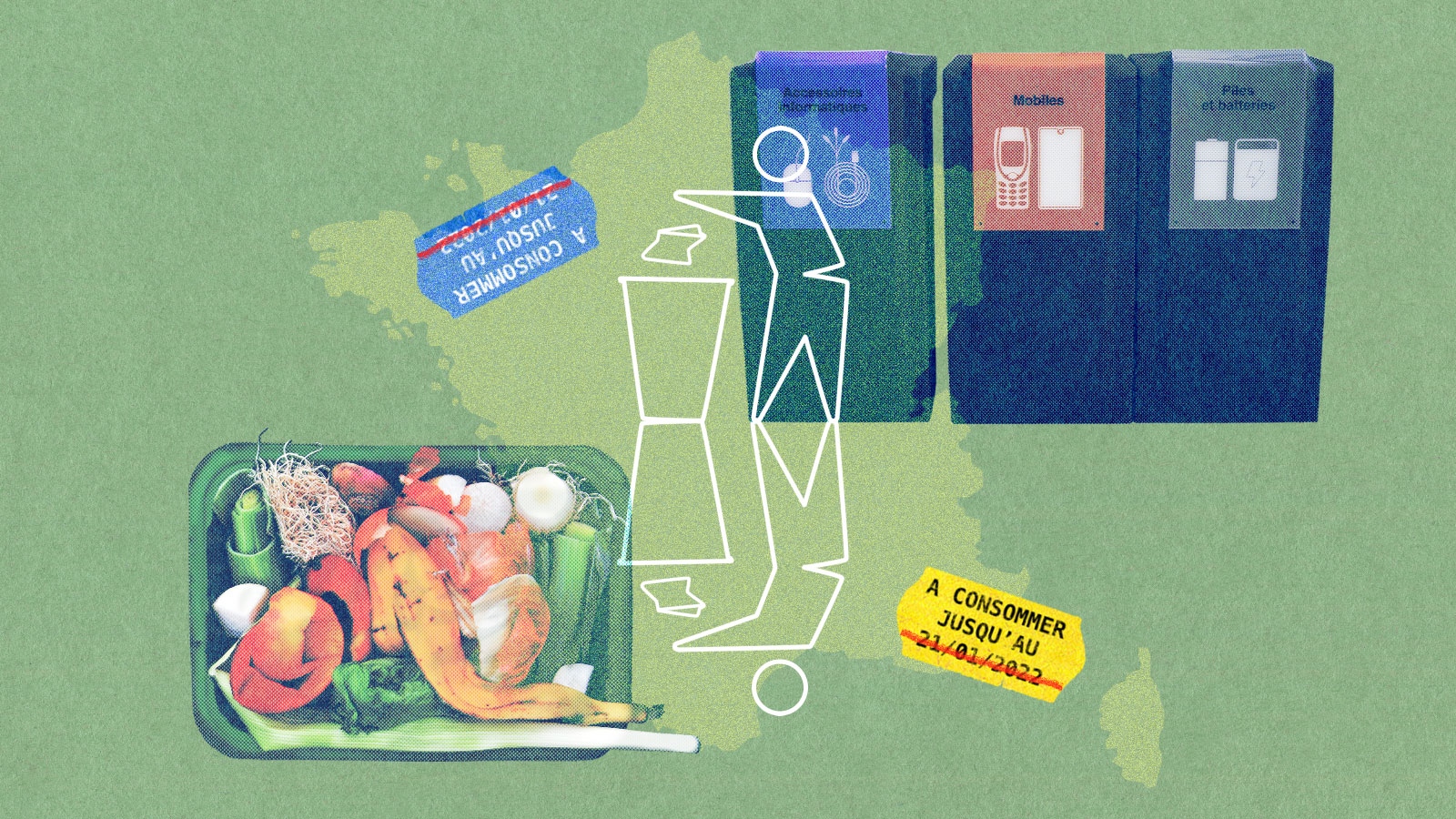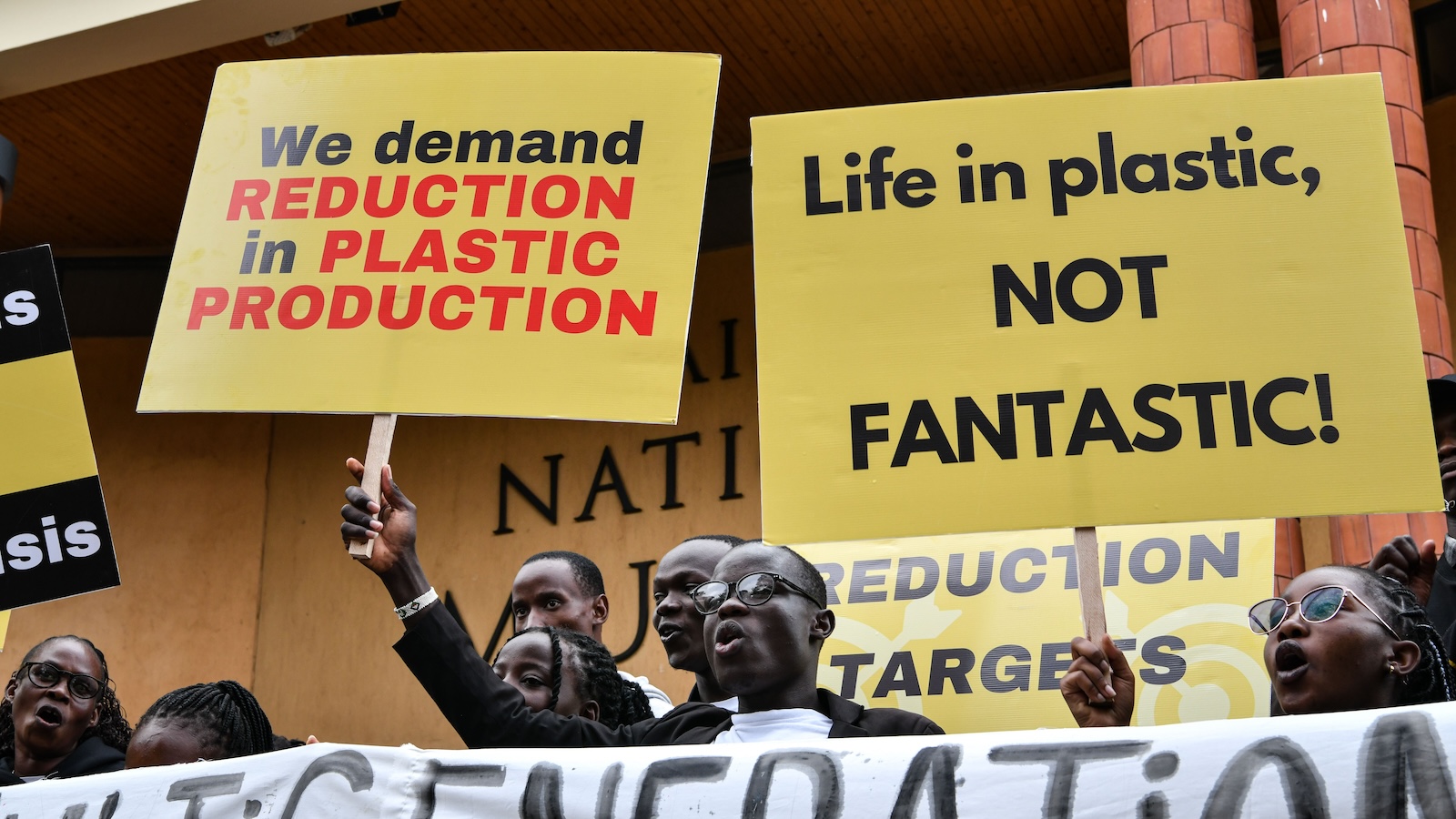For several months last year, patrons of a Seattle coffee shop called Tailwind Cafe had the option of ordering their Americanos and lattes in returnable metal to-go cups. Customers could simply borrow a cup from Tailwind, go on their way, and then at some point — perhaps a few hours later, perhaps on another day that week — return the cup to the shop, which would clean it and refill it for the next person. If it wasn’t returned within 14 days, the customer would be charged a $15 deposit, though even that was ultimately refundable if the cup was returned by the end of 45 days.
Tailwind’s head chef, Kayla Tekautz, said her cafe started the program out of a desire to address the environmental scourge of disposable plastic foodware and other packaging, the vast majority of which cannot be recycled. It was a partnership with a reusable packaging and logistics company called Reusables.com, which provided Tailwind and another Seattle area store, Cloud City Coffee, with branded cups and a QR code-operated drop-off receptacle.
But the cafe quickly ran into trouble. It was “overwhelming” to explain the return system to every interested customer, Tekautz said. Many were hesitant to participate after learning that they could only return the cups to Tailwind or the other drop-off location, 6 miles away. Plus, Tailwind’s QR code reader kept malfunctioning, requiring repeated visits from a mechanic. At the end of last summer, Tailwind quietly ended the return program. “It just didn’t work,” Tekautz said. (Reusables.com didn’t respond to Grist’s request for comment.)
In an effort to reduce consumption of single-use plastic, Seattle has spent the past several years encouraging local businesses to offer reusable cups, dishes, utensils, and packaging. It has made some laudable progress. Concertgoers at the Paramount Theater and attendees of the Northwest Folklife Festival, for example, can now order their libations in reusable polypropylene cups. And since 2022, students at the University of Washington have been able to check out bright green reusable food containers from a company called Ozzi.
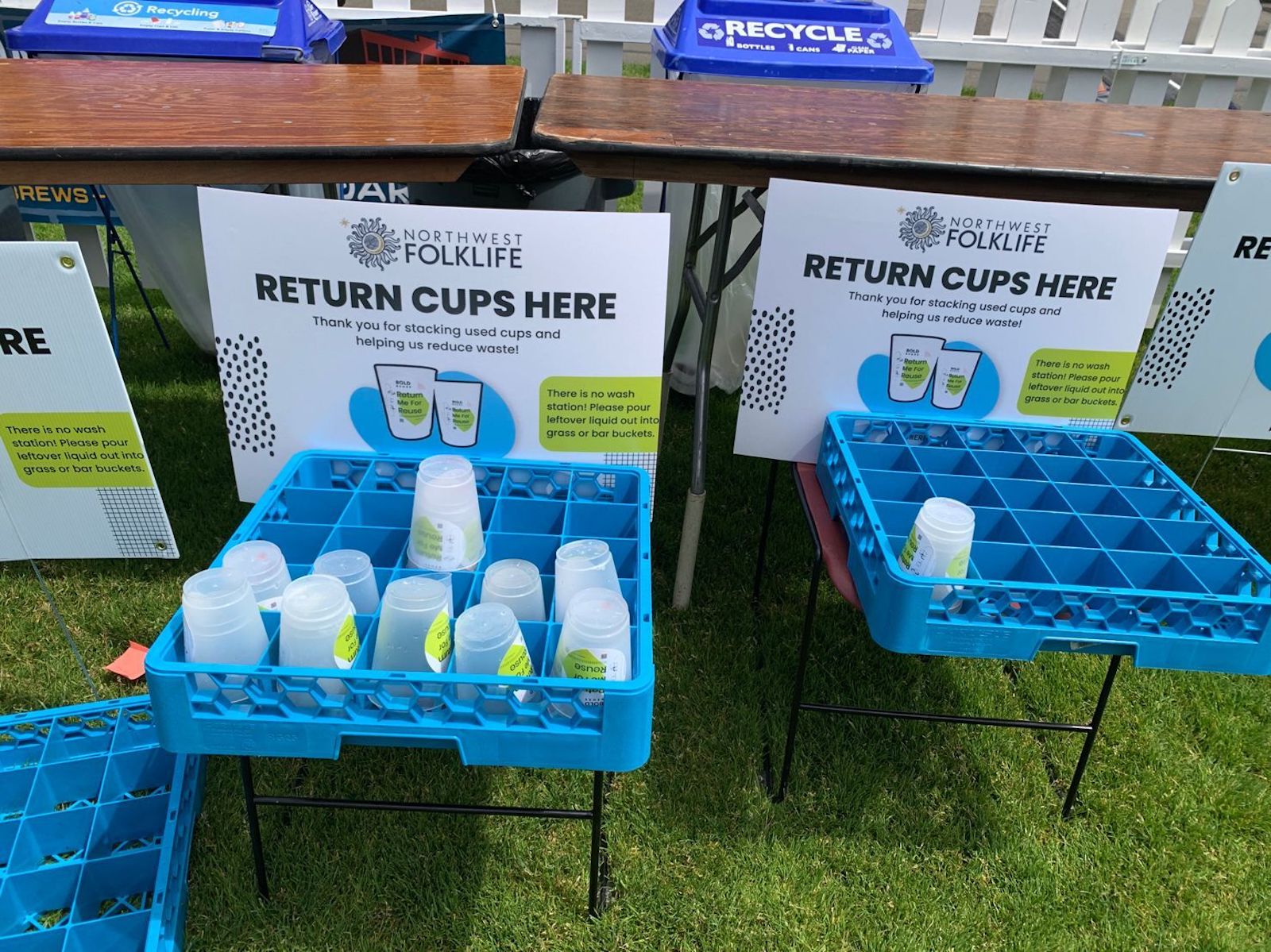
These programs are helping Seattle avoid single-use plastic and create a “waste-free future,” according to the city’s reuse website. It’s a target that’s being pursued by many American cities, and at the global level too. Disposable plastic foodware and packaging — which accounts for nearly 40 percent of all plastic production — can only be phased out if there are robust, efficient reuse systems to replace them.
But some businesses, like Tailwind, have struggled to get reusable containers off the ground, often because of the small scale and disconnected nature of existing reuse programs. Instead of pooling resources and employing just one or two large cleaning and logistics services, businesses have so far chosen among several competing initiatives — or in some cases, have created and run their own programs. The result is a slew of incompatible containers, specific to just a few stores or locations, and inefficient systems for gathering, washing, and transporting between customers’ homes, sanitation facilities, and storefronts.
Having so many companies creating their own designs and logistics can be expensive, causing them to miss out on economies of scale that could make reuse more affordable and easily adoptable. According to Ashima Sukhdev, a policy adviser for the city of Seattle, she should be able to “pick up a coffee from my local cafe, and then drop it off in the lobby of my office building. Or drop it off at the library, or at a bus stop.”
What Sukhdev is describing would represent a highly unusual level of coordination across company lines. At coffee shops, this would mean reusable mugs shared not only between Tailwind and Cloud City, but also Starbucks and Peets. For grocery stores, it could mean picking up a jar of olives at Safeway, dropping off the empty container at Walgreens, and then having the same jar refilled with jam and sold at Whole Foods. Achieving this would require companies to rethink the way they compete with each other and differentiate their products. It would also require big changes from consumers, who have been trained for 70 years to expect disposability in just about every aspect of daily life.
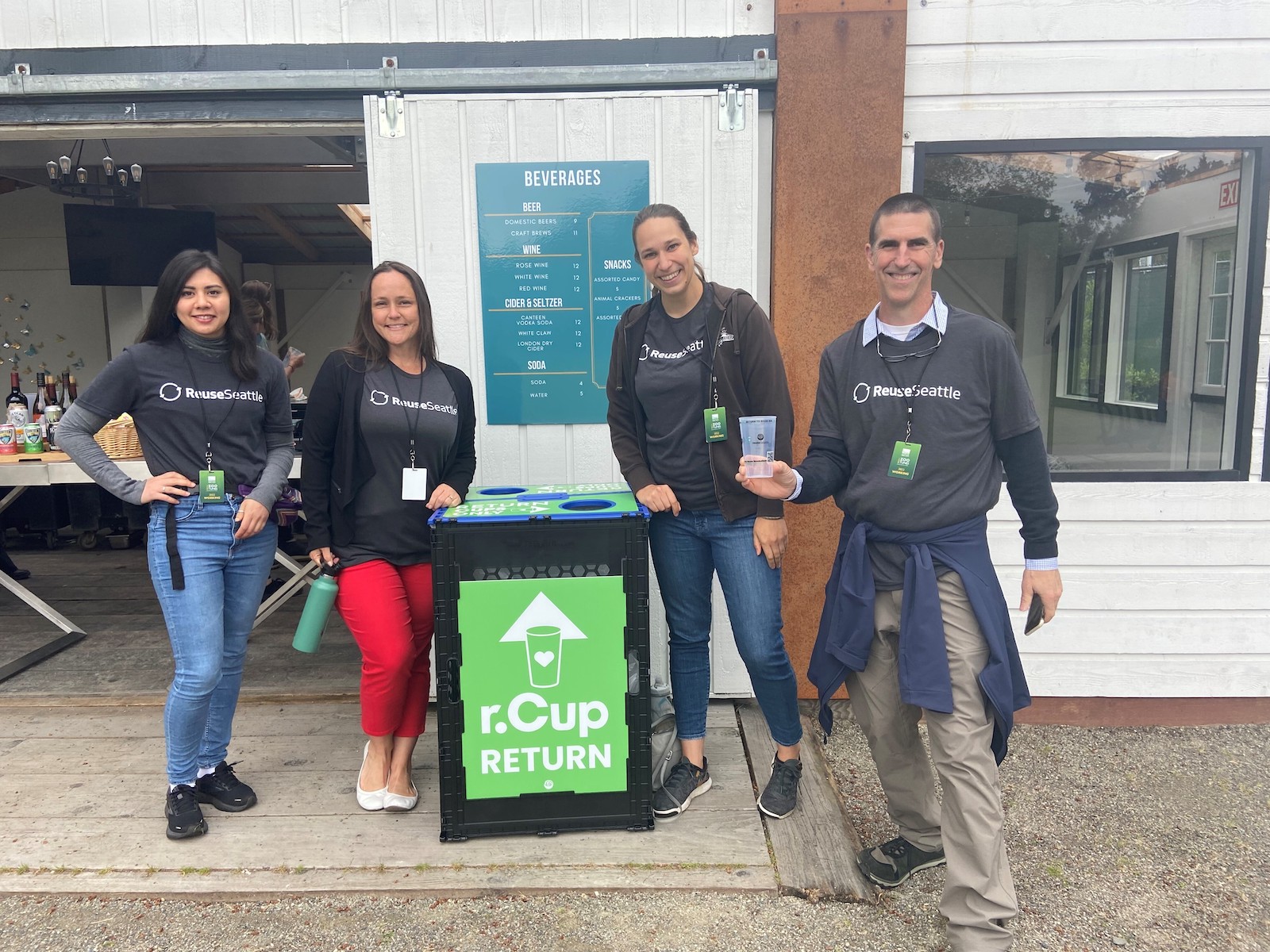
Experts say these changes are necessary. “For this solution to become a reality, you’re gonna need standards,” said Pat Kaufman, manager of Seattle Public Utilities’ composting, recycling, and reuse program.
Kaufman is currently on a yearlong sabbatical working for a nonprofit called PR3, which is trying to create those standards. The questions they’re facing are: What will standardized reusable packaging systems look like — and what will it take to get companies, and consumers, to adopt them?

Every year, the world produces about 400 million metric tons of plastic — almost entirely out of fossil fuels like oil and gas. Some of this is used in essential products like contact lenses and medical equipment, but a much greater fraction goes toward sporks, cups, bags, takeout containers, and other items that get thrown away after just a few minutes of use. Most of this plastic will never be recycled due to technical and economic restraints; more than 90 percent of all plastics get sent to a landfill or incinerator, or turn up as litter in the environment, where they degrade into microplastics and leach hazardous chemicals. Plastics manufacturing causes additional harms, including air pollution that disproportionately affects low-income communities and communities of color living nearby.
For all of these reasons, public pressure to cut back on single-use plastics has escalated dramatically in recent years. Many companies have responded by launching trials and pilot programs allowing customers to borrow and return reusable cups, bottles, trays, jars, and other containers. These include small players like Ozzi, as well as behemoth brands like Walmart and Coca-Cola. There have been “more trials than Donald Trump,” said Stuart Chidley, co-founder of a reusable packaging company called Reposit.
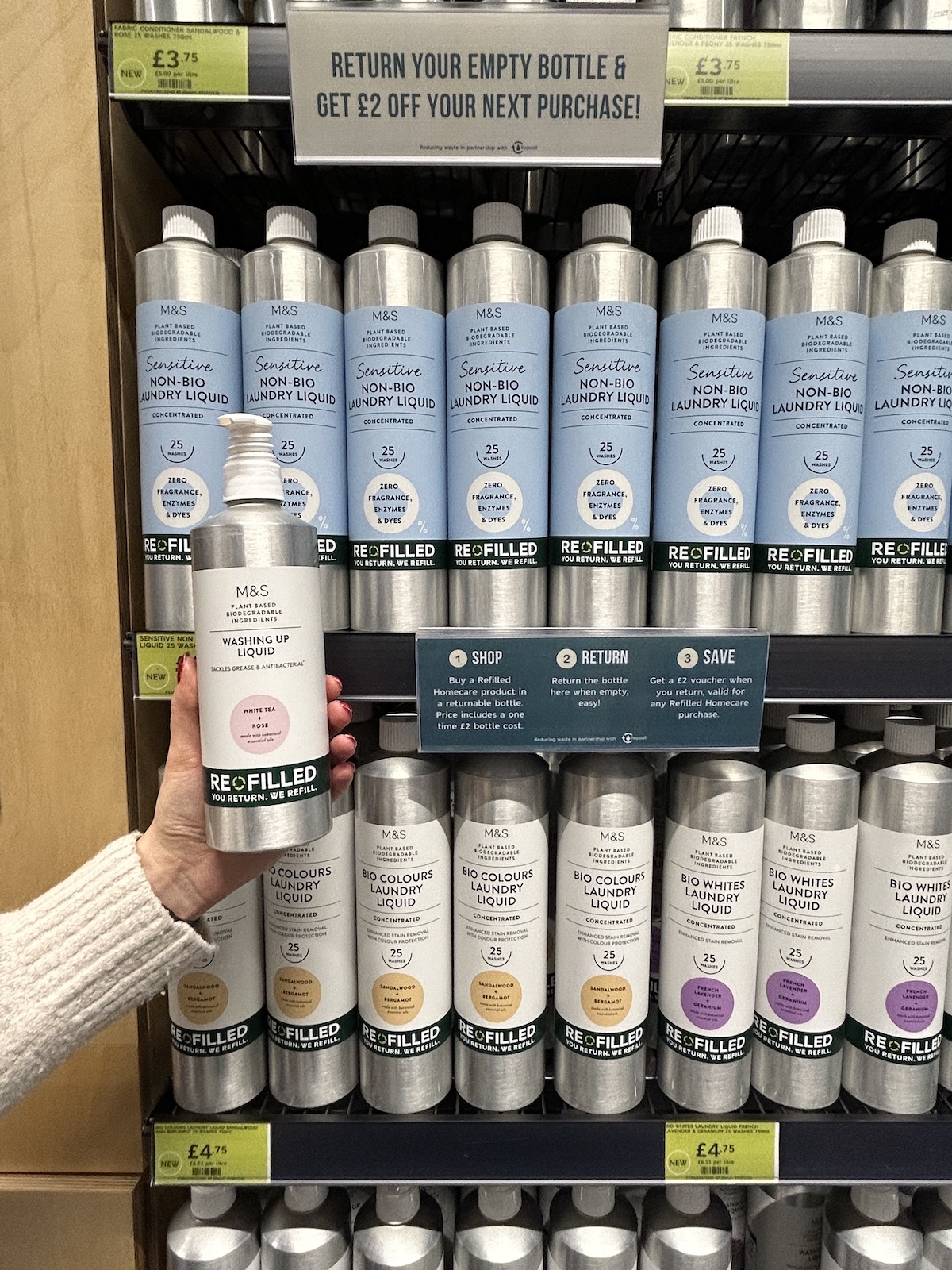
As in Seattle, however, their efforts have been siloed, making it hard for the reuse sector to grow. According to a recent report from the Ellen MacArthur Foundation, or EMF — a nonprofit that advocates for a “circular economy” that conserves resources — even companies that have pledged to dramatically scale down their use of plastics have only replaced 2 percent or less of their single-use containers with reusables.
“To realize the full benefits of return systems, a fundamentally new approach is required,” the authors concluded.
The four types of reuse systems
The EMF report focuses on reusable containers that you can return to the coffee shop, grocery store, or another drop-off point — known as “return on the go” — as opposed to those that consumers own and bring with them to stores. It says that three things need to happen to make reuse mainstream. First, companies have to achieve high return rates, so they don’t lose inventory when people steal or forget to return their containers. Second, they have to share infrastructure for washing, collecting, sorting, and delivery in order to achieve economies of scale. Third, reusable containers must be standardized. The third pillar makes the other two much easier to achieve, since it’s simpler to share logistics, scale up, and familiarize customers with reuse systems if they share common characteristics — for instance, if containers are designed with similar shapes, sizes, and materials.
To that end, PR3 has spent the past four years drafting standards for reuse systems, with a particular focus on container design. Through a “consensus body” composed of members from big business, the advocacy world, and government, PR3 is hoping to eventually certify the world’s first reuse standards under the International Organization for Standardization (known as ISO, to prevent confusion around different acronyms in different languages). This would lend legitimacy to the PR3 proposals, as the ISO maintains one of the world’s most widely accepted catalogs of standards. Others within its portfolio cover everything from food safety to the manufacturing of medical devices, and have been voluntarily adopted by many large companies and government bodies.
PR3 released a draft of its standards last year, and it’s been updating them behind closed doors since then. Specific standards on washing protocols are set to be published for public review this week, and the nonprofit hopes that its consensus body will vote to finalize standards for container design later this year.

PR3 released a draft of its standards last year, and it’s been updating them behind closed doors since then. Specific standards on washing protocols are set to be published for public review this week, and the nonprofit hopes that its consensus body will vote to finalize standards for container design later this year.
So, what makes a good reusable container system? It’s complicated. Containers have to hold up under the stresses of logistics and transportation. They have to be relatively inexpensive. Perhaps most intangibly, they have to seem reusable, so customers don’t accidentally throw them in the trash. This can be accomplished through design elements — like containers’ color, texture, shape, and weight — or through other means, like easily recognizable drop-off boxes for used containers. Some reuse advocates support deposit fees, in which customers pay a small amount, usually just a dollar or two, in order to borrow a reusable container. They get the deposit back once they’ve returned the container.
None of these features is guaranteed to work. In designing draft standards, PR3 has often had to make educated predictions about which ones consumers will respond to. And those predictions can have far-reaching implications. If you assume customers will frequently lose or forget to return their containers, for example, then it probably won’t make sense to design thick containers that are capable of withstanding hundreds of uses.
“In the real world, return rates vary wildly,” Claudette Juska, PR3’s technical director and one of its co-founders, told Grist. “You don’t want to design a container for 400 uses if it’s only going to be used four times.” The most recent version of PR3’s standards say containers must be designed to withstand at least 20 uses and reused in practice at least 10 times.
On the other hand, it may be counterproductive to design containers with the expectation that they won’t be returned. According to Chidley, with Reposit, cheap-looking and -feeling containers could actually cause low return rates, since people might be more careless with them. His philosophy is to use features like color, weight, and shape to communicate containers’ reusability, making it less plausible that people will confuse them for disposables.
PR3 doesn’t have much specific advice on these characteristics, but some entrepreneurs Grist spoke with said they’ve hit higher return rates through particular design choices. For Chidley, this means making containers “beautiful” through high-quality, heavier materials with stylish branding. His containers are available at Marks & Spencer grocery stores across England and Scotland. Lindsey Hoell, founder of a reusable container logistics company called Dispatch Goods and a member of PR3’s standards panel, has forgone sharp-edged takeout food containers in favor of ones with smoother edges that “feel fancier.” And because so many single-use plastics are either black or white, her containers are bright red. “There’s a lot of soft science of what makes a consumer feel like something is durable,” she told Grist. Her containers are available across most of the U.S., mostly through grocery and meal delivery programs like Blue Apron and Imperfect Foods.

To some extent, the discussion about expected use cycles and perceived quality is really just another way of asking what kinds of materials reusable containers should be made of: durable plastic or something else? Answering that question can bring into conflict businesses’ economic interests with concerns about health and the environment.
In the published draft of its standards from last year, PR3 recommended that reusable containers be “plastic-free,” citing plastic additives’ wide-ranging impacts on human health and ecosystems. Plastic can be cheap, light, and durable, but plastic-related chemicals have been shown to build up in people’s bodies and the environment, where they may contribute to hormone disruption, cancer, and reproductive harm.
PR3 panel members like Jane Muncke, chief scientific officer for the nonprofit Food Packaging Forum, supported the recommendation. “I don’t think plastics are suitable materials for reusable packaging,” she told Grist. She’s concerned about chemicals migrating into foods and beverages — especially hot, acidic, or fatty foods, which are better at soaking up some plastic additives. Durable plastics are also largely nonrecyclable; after being turned into new products a few times, they have to be thrown away or “downcycled” into lower-quality products like carpeting.
Still, many entrepreneurs and even the PR3 founders themselves have moved away from a hard-line stance against plastics. Hoell, for example, originally got into reuse because she was frustrated by plastic-strewn beaches in California — “I’m a surfer and I hate plastics,” she told Grist. She started out making stainless steel containers but soon discovered that rigid plastics had much lower up-front costs, giving her more wiggle room to deal with lower return rates. She didn’t have to worry as much about frequently lost, stolen, or damaged containers.
Plastic was also easier to transport because of its light weight, Hoell added, and she cited some analyses suggesting that it has a lower carbon footprint than alternatives like steel. (These findings are controversial, however; critics say it’s misleading to focus only on plastic-related carbon emissions and not the materials’ other dangers, like toxic chemicals leaching from landfills.)Dispatch Goods now only makes its containers out of polypropylene, a kind of plastic that’s generally considered more inert than others (although it can still leach hazardous chemicals). Other reuse logistics companies like R.world, which operates in Seattle and is also represented on the PR3 panel, have similarly opted for polypropylene containers instead of metal or glass.
At Seattle Pacific University, a reusable container program for students eating at the Gwinn Commons dining hall also uses rigid plastic. The containers’ low cost allows Sodexo, the school’s foodservice provider, to charge students just $5 to participate in its reuse system all year, without tracking return rates or worrying too much about lost inventory. “We don’t have a list of subscribers,” said Andrew Chaplin, the dining team’s general manager. The program “runs itself.”
Representatives from PR3 told Grist that plastic has been a hot topic of debate among consensus body members, and that the final version of the standards is likely to move away from the “plastic-free” recommendation. “The standards are going to address this with the understanding that if the world can move away from plastic, great, but in the meantime, before that’s feasible, we’d better move where we can,” said Amy Larkin, PR3’s co-founder and director, who pointed out that moving to reusable plastics will still make a huge dent in overall plastic demand. “Let’s get rid of 90 to 95 percent of the production of single-use packaging.”

Rather than calling for specific container shapes and sizes, PR3 has drafted a few broad requirements — like that containers be designed to “optimize durability,” and that they follow “best practices for recyclability.” They must comply with existing food-safety regulations. Optionally, companies may label products with a universal symbol — kind of like the ubiquitous “chasing arrows” used to indicate recyclability. Such a symbol doesn’t yet exist for reuse, but PR3 has proposed one: a black, white, or orange rose-like pictogram along with the word “reuse.”
More specific design elements are included only as recommendations. To make washing easier, for instance, PR3’s draft says reusable containers should have interior angles no smaller than 90 degrees, as well as “feet” to maximize airflow during drying. They also say containers should “nest” to save storage space and make transportation easier.
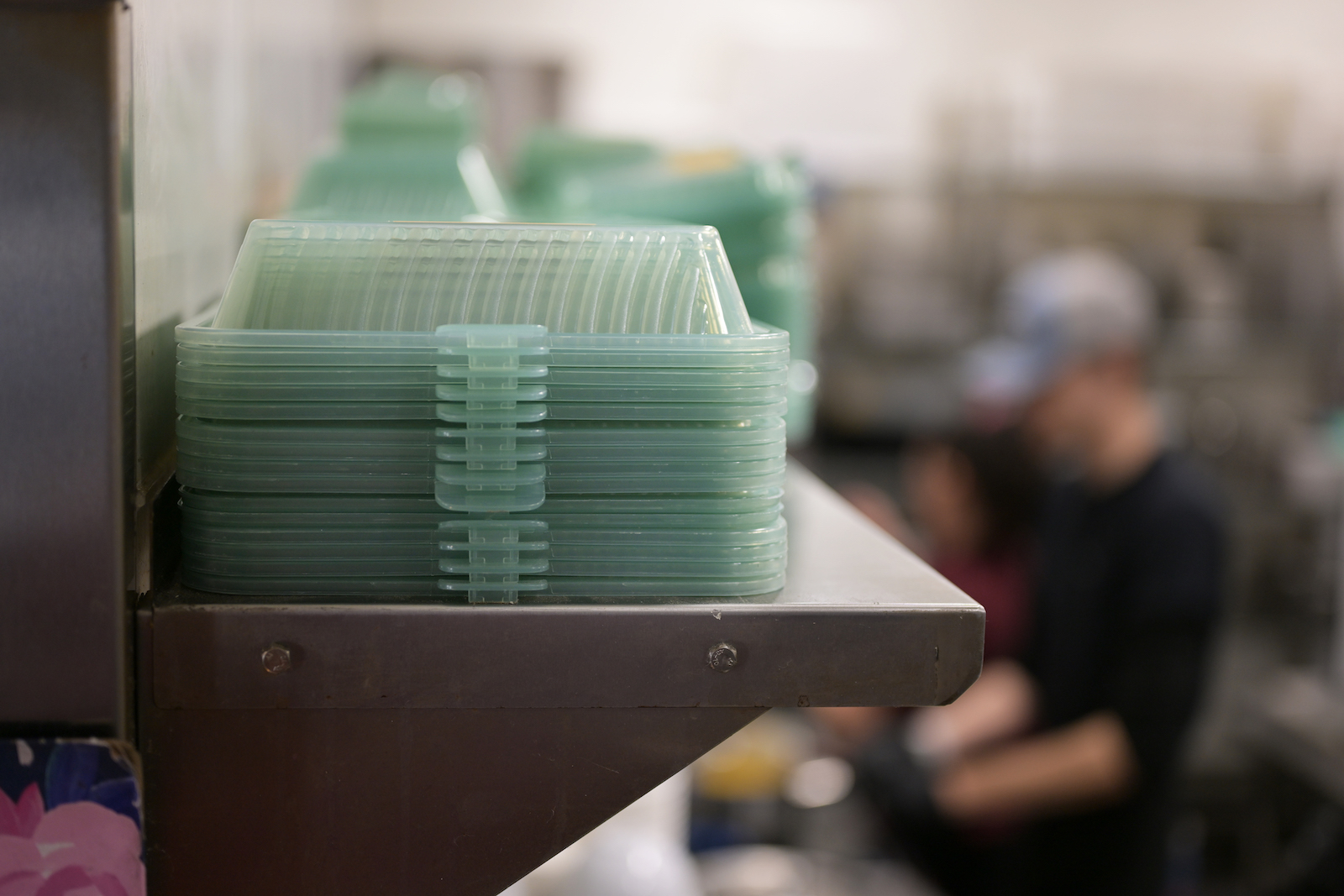
This flexible approach fits into a category that EMF calls “bespoke with shared standards,” where containers can vary from brand to brand while still sharing common characteristics — like where labels are placed, or the width of a bottle’s mouth. This leaves big brands free to design their own unique packaging if they want to.
PR3’s approach aims to appease big businesses by allowing them to keep using containers that look and feel very different, so long as they conform to a set of broad requirements. “Product companies want that kind of autonomy,” Juska told Grist.
Coca-Cola, for example, sets itself apart with its iconic — and patented — hourglass-shaped Coke bottle. And beauty companies are notorious for differentiated packaging: Walking down the perfume aisle, you might see bottles shaped like everything from a high-heeled shoe to a kitten.
Many reuse advocates want to do away with those unique container designs, going even further than what PR3 has suggested in order to enable sharing among different companies — a situation where packaging is considered “pooled” within a market. So instead of an extravagant diversity of perfume bottles, all fragrances might come in interchangeable cylindrical jars.
A small number of companies — especially in Europe — already do this. For example, through a German program called Mach Mehrweg Pool (roughly translated to “Make Reuse Pool”), brands share a collection of identical glass jars that can be filled with different foods. When consumers return the empty containers to a supermarket, a logistics provider picks them up and brings them back to food producers for cleaning. Another organization called the German Wells Cooperative runs a similar program for reusable soda and water bottles, counting more than 150 beverage makers as members.
Other companies that have experimented with pooling, however, have only done so within the brands they control. Coca-Cola, for instance, has a “universal bottle” initiative in South America in which a single, standardized reusable bottle can be used for all of its beverage brands — Fanta, Sprite, Coke, and others. But the initiative is not universal across company lines; you couldn’t refill a Coke bottle with Pepsi.
Tom Szaky, founder and CEO of Loop, a “global reuse platform” that is represented on the PR3 panel, said standard-setters shouldn’t try to resist companies’ impulses to differentiate. Brands should be allowed to experiment with both unique and standardized reusable packaging and then “let the market decide” which is preferable, he told Grist. Others, like Kaufman, have raised concerns that pooling might not make sense for some particular products — like baby food, since shared containers can increase the risk of contamination, and babies are more vulnerable to illness.
There is already evidence, however, that companies are leaving money on the table by choosing not to pool their containers. According to EMF’s direct comparison of pooled and nonpooled standardized packaging, pooling containers reduces the cost of reusable packaging systems by up to 28 percent.
Plus, at least some intervention — perhaps regulation or financial incentives — is likely required to create conditions that are more favorable to reusables; a hands-off, market-led approach is what has led to today’s proliferation of throwaway plastics. EMF’s modeling suggests that only reuse systems “built collaboratively from the outset” can reach cost parity with single-use. Exactly what that collaboration will look like, however, is unclear, since the kinds of government regulations that could help foster it might be incompatible with the United States’ free market ethos and antitrust laws. Internationally, some cities and countries have done more than the U.S. to promote reuse, but none has gone as far as what EMF is suggesting.
Plus, at least some intervention — perhaps regulation or financial incentives — is likely required to create conditions that are more favorable to reusables; a hands-off, market-led approach is what has led to today’s proliferation of throwaway plastics. EMF’s modeling suggests that only reuse systems “built collaboratively from the outset” can reach cost parity with single-use. Exactly what that collaboration will look like, however, is unclear, since the kinds of government regulations that could help foster it might be incompatible with the United States’ free market ethos and antitrust laws. Internationally, some cities and countries have done more than the U.S. to promote reuse, but none has gone as far as what EMF is suggesting.

Even in the absence of robust regulations, PR3’s standards are likely to nudge the country — and the world — in the right direction. Once they’re finalized, PR3 plans to submit them to the American National Standards Institute, the U.S. member organization of the ISO. From there, the standards would be opened up to public comment, potential revisions, and then final approval. PR3 would have to go through a separate submission and review process to get the standards approved by member countries of the ISO.
What would happen next is unclear. Other ISO standards — like for information security and energy efficiency — have been voluntarily adopted by individual companies or industry groups, either because they contain genuinely useful guidance on a complicated issue or because they increase businesses’ perceived trustworthiness.
ISO standards can also inform government regulations and international agreements. According to Juska, PR3 is already in talks with Canada’s environment ministry to shape new rules on reusable packaging, and the same thing could happen in any number of other jurisdictions. Juska is also hopeful that PR3’s standards will be acknowledged by or incorporated into the United Nations’ global treaty to end plastic pollution. The latest draft of the treaty mentions the need for standards — including for reusable packaging systems — some three dozen times, which Juska said is indicative of how “desperately needed” they are.
“If we want everyone to move in the same direction, we need to set some design parameters for how we want the system to function,” she said.
This story was originally published by Grist with the headline What will it take to get companies to embrace reusable packaging? on May 1, 2024.
This post was originally published on Grist.

